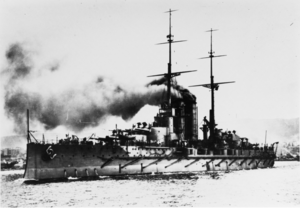 Prinz Eugen underway
| |
| History | |
|---|---|
| Name | Prinz Eugen |
| Namesake | Prince Eugene of Savoy |
| Builder | Stabilimento Tecnico Triestino, Trieste |
| Cost | 60,600,000 Krone |
| Laid down | 16 January 1912 |
| Launched | 30 November 1912 |
| Commissioned | 8 July 1914 |
| In service | 1914–1918 |
| Out of service | 1918 |
| Homeport | Pola |
| Fate | Transferred to State of Slovenes, Croats and Serbs on 31 October 1918 |
| Name | Prinz Eugen |
| Acquired | 31 October 1918 |
| Fate | Handed over to the Allied powers on 10 November 1918 |
| Name | Prinz Eugen |
| Acquired | 25 August 1920 |
| Fate | Ceded to France under the Treaty of Saint-Germain-en-Laye in 1920, sunk as a target ship on 28 June 1922 |
| General characteristics | |
| Class and type | Tegetthoff-class battleship |
| Displacement |
|
| Length | 152 m (498 ft 8 in) |
| Beam | 27.90 m (91 ft 6 in) |
| Draft | 8.70 m (28 ft 7 in) |
| Installed power | |
| Propulsion | 4 shafts; 4 steam turbine sets |
| Speed | 20 knots (37 km/h; 23 mph)[a] |
| Range | 4,200 nmi (7,800 km; 4,800 mi) at 10 knots (19 km/h; 12 mph) |
| Complement | 1,087[1] |
| Armament |
|
| Armor | |
SMS Prinz Eugen (His Majesty's Ship Prinz Eugen)[b] was the third of four Tegetthoff-class dreadnought battleships built for the Austro-Hungarian Navy. Prinz Eugen was named for Prince Eugene of Savoy, a Habsburg general and statesman during the 17th and 18th centuries most notable for defeating the Ottoman Empire at the Battle of Zenta in 1697. The ship was armed with a main battery of twelve 30.5 cm (12.0 in) guns in four triple turrets. Constructed shortly before World War I, she was built at the Stabilimento Tecnico Triestino shipyard in Trieste, where she was laid down in January 1912 and launched in November that same year.
Commissioned into the Austro-Hungarian Navy just 10 days after the assassination of Archduke Franz Ferdinand, Prinz Eugen was a member of the 1st Battleship Division of the Austro-Hungarian Navy at the beginning of the war alongside the other ships of her class, and was stationed out of the Austro-Hungarian naval base at Pola. She first saw action during the Bombardment of Ancona following Italy's declaration of war on Austria-Hungary in May 1915, but saw little combat for the rest of the war due to the Otranto Barrage, which prevented the Austro-Hungarian Navy from leaving the Adriatic Sea. In June 1918, in a bid to earn safer passage for German and Austro-Hungarian U-boats through the Strait of Otranto, the Austro-Hungarian Navy attempted to break the Barrage with a major attack on the strait, but it was abandoned after Prinz Eugen's sister ship, Szent István, was sunk by torpedoes launched from the Italian torpedo boat MAS-15 on 10 June.
After the sinking of Szent István, Prinz Eugen and the remaining two ships of her class, Viribus Unitis and Tegetthoff, returned to port in Pola where they remained for the rest of the war. Facing defeat in the war in October 1918, the Austro-Hungarian government decided to transfer the bulk of its navy to the newly formed State of Slovenes, Croats and Serbs in order to avoid having to hand the ship over to the Allies.[2] This transfer however was not recognized by the Armistice of Villa Giusti, signed between Austria-Hungary and the Allies in November 1918. Under the terms of the Treaty of Saint-Germain-en-Laye, Prinz Eugen was handed over to France. The French Navy subsequently removed the main armament of Prinz Eugen for inspection before using the battleship as a target ship. After being first used to test aerial bombardment attacks, Prinz Eugen was sunk by the battleships Paris, Jean Bart, and France off Toulon on 28 June 1922, exactly eight years after the assassination of Archduke Franz Ferdinand.
Cite error: There are <ref group=lower-alpha> tags or {{efn}} templates on this page, but the references will not show without a {{reflist|group=lower-alpha}} template or {{notelist}} template (see the help page).
- ^ Sieche 1991, p. 133.
- ^ Sokol 1968, p. 139.